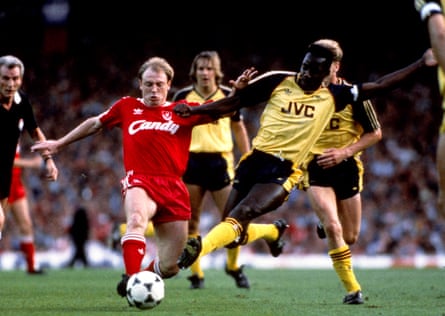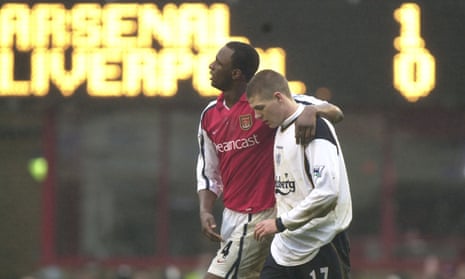With the Guardian’s unstoppable rise to global dominance** we at Guardian US thought we’d run a series of articles for fans wishing to improve their knowledge of the sport’s history and storylines, hopefully in a way that doesn’t patronise you to within an inch of your life. A warning: If you’re the kind of person that finds The Blizzard too populist this may not be the series for you.
** Actual dominance may not be global. Or dominant
When Arsenal won the 1990-91 league title, with Liverpool nine points behind them but a further seven ahead of third-placed Crystal Palace, it felt like a reinforcement of the modern-day order. The previous time both sides had finished outside the top two was 1981; the intervening years had bred a legend that would resonate for decades and, for supporters cutting their football teeth in the seasons either side of Italia 90, the significance of their meetings was in little doubt. Arsenal v Liverpool, Liverpool v Arsenal – it was the top flight’s hottest ticket.
It is still a pretty warm one and whatever happens when they play at the Emirates on Friday may have a lasting impact on this term’s jostle for the Champions League places. Last season’s fixture certainly did: had Liverpool not won a topsy-turvy encounter 4-3 on the opening weekend, Arsenal would have snatched fourth place ahead of them and avoided an autumn of second-string strolls against Bate Borisov. They are fighting for similar spoils now and it remains a big deal – just not as big as it used to be.
Yet the allure persists and that is because history, its remembering and its reviewing, plays as big a part as anything in making the Premier League what it is. If nothing about Arsenal v Liverpool has quite been the same since 1991 it is because, in the first instance, the Merseyside club declined rapidly after that – only occasionally finding themselves in the title mix while Arsenal, invigorated by Arsène Wenger, became the most exciting side seen in the Premier League’s first dozen years. Arsenal’s own slow drift since 2006 has, essentially, meant the two generally meet halfway – on the fringes of any battle for top spot.
They remember all too well the night when they did meet for the highest stakes of all. Simply google the date, 26 May 1989, and the most visible entry tells the tale. That is how deeply Liverpool 0-2 Arsenal, and Michael Thomas’s dramatic late decider for the Gunners, are etched into football folklore and into wider sporting culture, too. No English top-flight season has ever had an ending of remotely comparable drama. “I don’t even like watching my goal in case Ray Houghton tackles me,” Thomas said later. Millions more do, though, and the moment had huge ramifications: in a dark period for football, coming six weeks after the Hillsborough disaster and almost exactly four years after the Heysel tragedy that saw English clubs banned from European competition, here was a shaft of light for what the sport itself could be.

More prosaically, it was the latest in a line of decisive meet-ups that saw Arsenal came out on top. Although Liverpool broadly had a stranglehold on English football from 1973 until that night in ’89, the London club could point to the 1971 FA Cup final, when a young Charlie George scored an extra-time winner from 20 yards. His celebration, lying flat on the Wembley turf with his arms aloft, has never left minds of a certain vintage. A little less visually profound, although the black and white footage can be located easily enough, is Arsenal’s 2-0 cup final win in 1950 – brought about by two goals from Reg Lewis. The photograph of Joe Mercer, the Arsenal captain, held aloft by team-mates has its own fond place in the club’s hearts and minds.
Arsenal, then, had the show-stopping moments in an opening century of skirmishes that began in 1893. Back then Arsenal were, of course, based in Woolwich and they were roundly beaten 5-0 at home in the first-ever encounter. That fixture took place in the old second division; there was no top-flight meeting until 1905 but neither club has spent much time away from the upper reaches since them and, as a remarkable total of 223 meetings suggests, there are few more reliable or long-standing rivalries at such a high level in the sport.
Liverpool hold the head-to-head record for victories – 86 v 78 – but the ones that resonate most for them came after the turn of the millennium. In 2001 Arsenal were 1-0 up and poised for a third FA Cup final against their adversaries when, from nowhere, Michael Owen popped up with two clinically-taken goals in the last seven minutes. It felt all the sweeter for Liverpool, and the more gutting for Arsenal, that their centre-back Stephane Henchoz had not been penalised for an earlier handball on the goal line. Arsenal had finished runners-up in the league to Manchester United, with Liverpool third, and would go one better in both competitions the following year.
There was more to come in 2008, when Liverpool scored twice at the death to settle a thrilling Champions League quarter-final at Anfield. They won 5-3 on aggregate, serving up another reminder that the one part of Liverpool’s success Arsenal cannot really touch is their far superior level of success in Europe. High-scoring affairs have become commonplace in recent years: the Andrey Arshavin-inspired 4-4 in 2009 is perhaps the most notable but Liverpool’s 5-1 win in 2014 and a 4-1 Arsenal success a year later also stand out.
Nobody would bet against the goals flowing again on Friday. The memories surely will too and, beneath it all, there will be a mutual respect between two clubs whose relationship has been friendly and sporting. What they would both give, though, to be fighting for a place at the head of the table – rather than merely a seat at it.

Comments (…)
Sign in or create your Guardian account to join the discussion